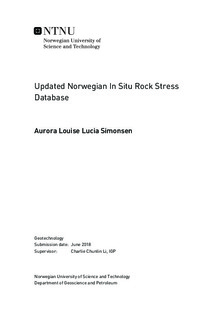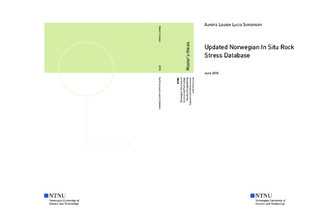| dc.description.abstract | This thesis presents an updated Norwegian in situ rock stress database and collected in situ rock stress data. In situ rock stresses are the stresses that are present in the ground before any disturbance. Knowledge of in situ stresses is of importance for the safety and stability of man-made structures in rock masses, and they also play a fundamental role in the development of geological structures. The database created for this thesis consists of four tables where one serves as the main table. The main table contains information about the in situ stress field, about bedrock and description of location. The other tables contain test data from rock stress measurements and data uncertainty.
Throughout the work of this thesis there have been collected 115 data records that were obtained with different measurement (overcoring and hydraulic fracturing) and estimation (borehole breakouts, drilling-induced-fractures and focal mechanism) methods. Measurement data makes up 36 % of the database and the data has overburdens from 11-1300 m. Estimation data makes up 64 % of the data and the data covers a depth range from about 1000 m-50 km.
A N-S and a WNW-ESE major horizontal stress orientation dominate the estimation data from offshore Norway and western, mid and eastern Norway. This is consistent with the ridge push effect from the mid-Atlantic ridge. The measurement data from onshore Norway had scattered orientations that could be caused by local effects. The major horizontal stress generally exceeded the vertical stress in the Norwegian region with an average ratio of 1.2. Calculations indicated that the sedimentary rocks had more stress anisotropy than igneous and metamorphic rocks, and that the Precambrian rocks had higher stress magnitudes than Cambrian-Silurian rocks. It also seemed that the stress gradients decreased with increasing overburden. However, the calculations are based on small data sets which reduces the reliability of the results. To improve the reliability of the results and get more information about stress orientations, more in situ rock stress data should be collected, especially from onshore Norway.
The effect of topography on the in situ stress field was evaluated by studying four data points located in mountain sides. The effect of topography on the principal stress orientations seemed to decrease inwards in the rock mass. There were also indications of horizontal stress concentration beneath the valleys. | |

